The following article originally appeared on RBC Wealth Management’s website.
RBC has a powerful story to tell about its 150 years of existence. From a group of merchants trading on the shores of Halifax, to a top global bank with assets and employees spanning the world, the story might seem fictional if it weren’t absolutely true.
There are insights to be gleaned from that story: How the bank grew from nothing, and managed to survive some of history’s most monumental challenges — both world wars and the Great Depression, to name just a few. This is a tale that closely tracks Canada’s own story.
“By learning from the past, we can use that to learn in the present,” says Davina Boulton, manager of the bank’s reference services and knowledge assets.
Here are a few key moments from the past 150 years.
1864: Merchants’ Bank — RBC’s original name — was founded on the Halifax waterfront, providing credit to tradesmen importing and exporting through the port. The eight founding merchants included prominent local names like Thomas Kinnear, Edward Kenny and William Cunard.
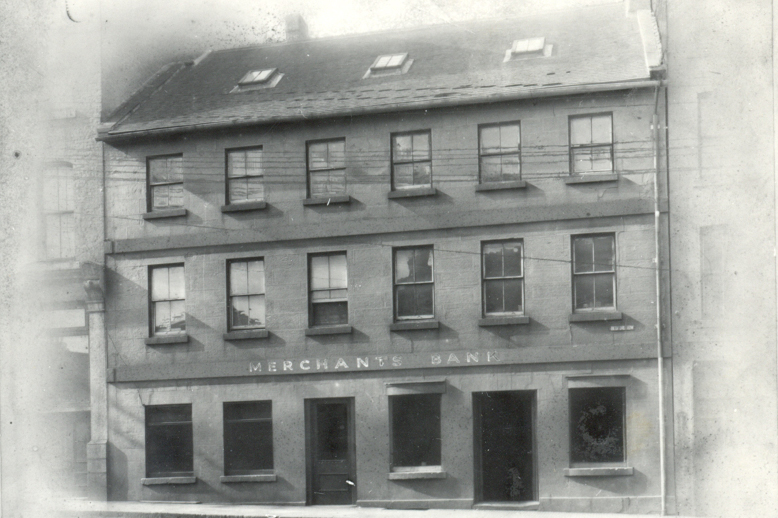
RBC’s building on Bedford Row, Halifax, served as our first head office and Halifax branch from 1864 – 1879.
That original boardroom table still exists, notes Elizabeth Court, current manager of acquisitions and holdings for the RBC corporate archives. It’s tucked away in the executive suites of Montreal’s Place Ville-Marie offices.
1869: Merchants’ Bank of Halifax gains a federal charter, not long after Canada’s Confederation in 1867. In the early years, the boardroom was divided between those who were Maritime-focused, and those who saw potential in this new country called Canada. At this time the bank’s notes, deposits and current accounts totalled $500,000.
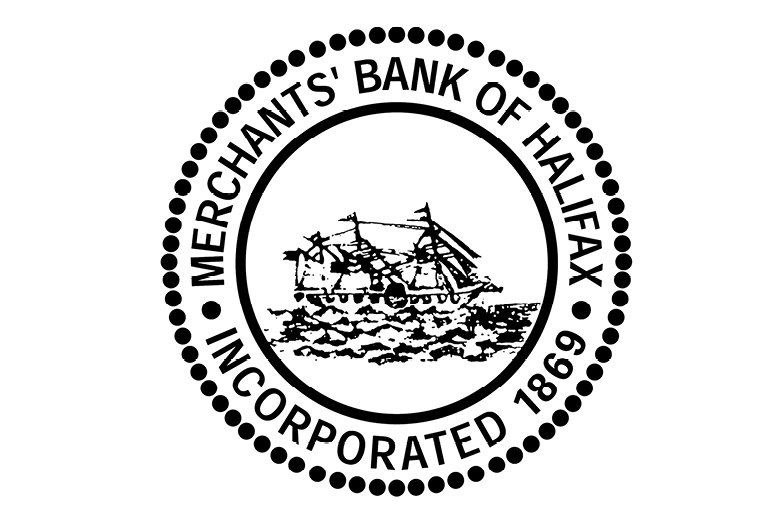
1870: The young nation’s Bank Act was created, essentially providing the operating system for the nation’s financial institutions. Every decade afterwards, the Bank Act would be tweaked and renewed for a changing environment.
1882: The little Halifax bank started crossing borders, with a presence in Hamilton, Bermuda in 1882; Havana, Cuba in 1899 and New York in 1899.
1891: Royal Bank’s first donation on record was to the Springhill Mine Accident Relief Fund, for $250. That was the first seed planted for what would become a long and important history of corporate citizenship.
1899: Edson Pease was appointed the bank’s general manager — a man identified by RBC archivist Elizabeth Court as a true “mover and shaker” who was one of the most towering figures in the bank’s history. “It was under him that it went from a small regional operation, to a truly national bank.”
1901: Merchant executives who supported westward expansion won the day in the boardroom, and that required a name change to something more inclusive — to Royal Bank of Canada. Branches by this time were operating coast-to-coast, with a number having been opened in British Columbia to accommodate the Klondike gold rush.
1902: Early banking was very much a male-dominated affair, but this year the first woman was employed by Royal Bank: Jennie Moore, a secretary in Vancouver, B.C.
1903: The first branch in the burgeoning city of Toronto opened at the corner of Yonge & Wellington. It wasn’t the first Ontario branch, though, with one in Ottawa having started business in 1899.
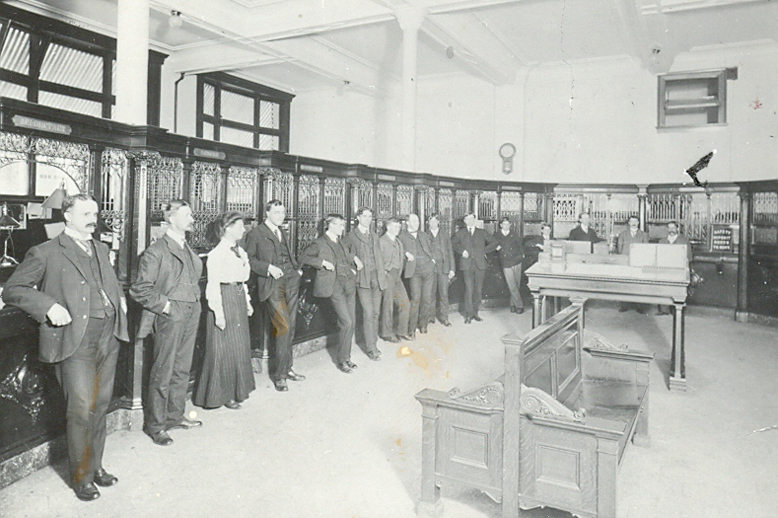
Employees lined up inside RBC Vancouver main branch in 1904.
1907: The centre of gravity for the young nation’s financial system was St. James Street in Montreal. Acknowledging this, the bank officially moved its headquarters from Halifax to Montreal. Not long after, in 1911, the bank would report its first million-dollar annual profit.
1912: Stephen Leacock’s iconic book “Sunshine Sketches of a Little Town” was released, with a key character based on an actual Royal Bank employee: George Rapley of the Orillia, Ont. branch.
1914: With World War I breaking out, the Canadian workforce would be forever changed. By 1918, 1,495 Royal Bank men had enlisted, and 191 paid the ultimate price. To put this sacrifice in perspective, total bank staff in 1914 numbered 2,832. As a result, large numbers of women started working for the bank, helping bring about a major societal shift.
1918: Postwar expansion included branches in Barcelona in 1918, and Paris in 1919. Brazil and Argentina soon followed in 1919, as did Colombia and Peru.
1925: The era of bank amalgamation was well underway, led by Edson Pease, as RBC incorporated institutions like Union Bank of Canada and Northern Crown. By this time, the bank had 18.7 per cent of Canadian bank assets. Royal Bank by this time had branches in 801 Canadian communities, and was Canada’s largest bank.
1929: Royal Bank’s assets peaked at a billion dollars, but the Great Depression was soon to hit in the U.S. Edson Pease passed away in 1930, with Morris Wilson taking the reins during what would become a very tumultuous period.
1929: The RBC Art Collection was first formed. From modest beginnings, the collection now numbers 4,500 works, housed across offices in Canada, New York City and London.
1933: The institution was close to insolvency in 1932-33, as bank after bank failed south of the border. Assets fell to $729 million, and Bank of Montreal became the nation’s biggest. When the Depression was over by the end of the decade, though, not a single Canadian bank had failed.
1940: The World War II and the war economy shocked the country back to life, but brought great sacrifice along with it. Royal Bank assets grew from $955 million to $2 billion in five years. More than 2,300 bank employees enlisted in the war effort, and around 200 never came home. Bank president Morris Wilson participated in the war effort, helping ensure critical supplies made their way to Europe.
1947: Royal Bank first sponsored the Canadian Olympic Association. It would go on to become the longest Olympic sponsorship in Canadian history.
1955: Postwar boom years were transforming Canada and its economy. A million new depositors came to Royal Bank in a single decade, with over 2.5 million total accounts. The bank, under the leadership of Jimmy Muir, started to expand into consumer mortgages. By 1958, Royal Bank held 38 per cent of all mortgages in the country.
1960: The economic boom continued, with three million consumer accounts and $4 billion in deposits. Royal Bank accounted for a quarter of the entire Canadian banking industry. W. Earle McLaughlin, another mammoth figure in the bank’s growth, assumed the presidency from Jimmy Muir.
1961: Royal Bank played a key role in the aftermath of the “Bay of Pigs” invasion: With captured troops held abroad, and the U.S. and Cuba not speaking to each other, Royal Bank employees acted as intermediaries, ensuring their freedom in return for medicine and food.
1961: Royal Bank became the first Canadian bank to install a computer, an IBM 1401. It occupied a full room and was used for accounting. Later, in 1967, it would make the first Canadian banking transaction by computer: a deposit.

An employee with RBC’s first computer in 1962.
1962: Royal Bank played a pivotal role in the creation of Canada’s first skyscraper, Place Ville-Marie in Montreal. The location became its headquarters and plays a critical role to this day.
1967: A defining year for a nation coming of age. The revised Bank Act revolutionized the industry from its staid past — there was no longer a six per cent ceiling on bank lending, mortgages were more widely available, and new products like credit cards, consumer loans and mutual funds became commonplace.
1968: Georgette St. Cyr became the first woman appointed as a Royal Bank branch manager (Place Longueuil branch, Montreal, Quebec). The bank also rolled out its advertising strategy of the teller “Mary” in 1968. First on radio, then in print and on TV, Mary was at one time the best-known advertising personality in the country.
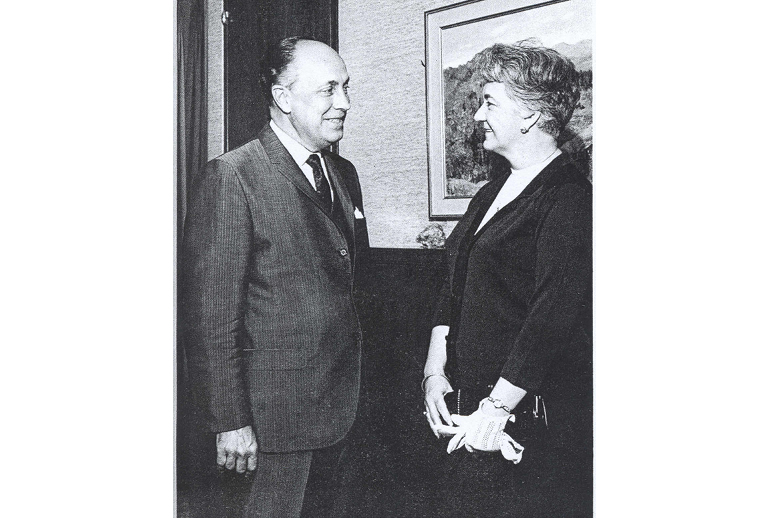
Georgette St. Cyr, the first female Branch Manager for RBC.
1972: Fourteen Toronto branches were supplied with “Bankette” machines, precursors to the modern ATM. At the same time Royal Bank was greatly expanding its credit card offerings, signing up more than 570,000 clients for its “Chargex” product. The initial personal credit line: $300.
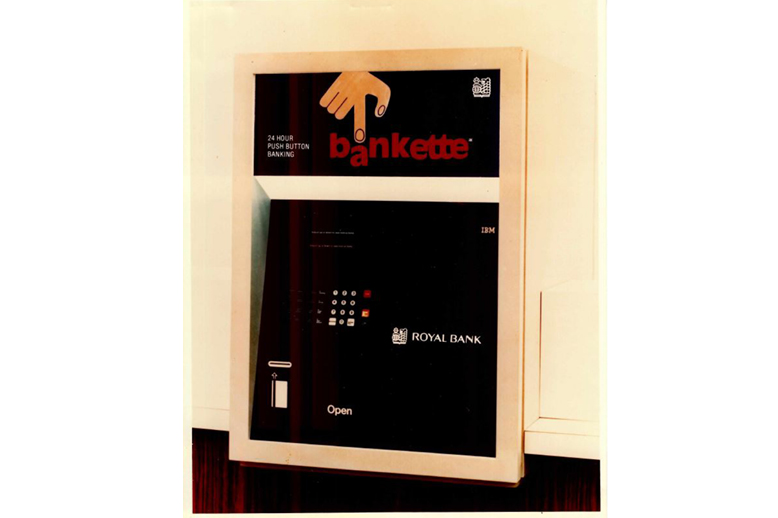
The RBC Bankette, circa 1970, offered “24 hour push button banking.”
1976: Royal Bank Plaza opened in Toronto, underscoring the city’s increasing importance as a financial centre. Some critical head-office functions like investments, international money markets and corporate marketing were shifted from Montreal.
1979: Suzanne Labarge became the bank’s first female executive, as Assistant General Manager for International Loans. The glass ceiling cracked a more with Gwyn Gill’s 1984 appointment as Vice-President of Organization Planning and Development. This movement towards the recognition and promotion of women, including a dedicated task force, began under executive Rowland Frazee, notes RBC’s Court.
1980: McLaughlin oversaw a period of astonishing growth, from $4 billion in assets in 1960 to $62 billion in 1980. From around 1,000 branches in 1960, by 1980 the bank had 1,592 branches around the world. In 1981, Personal Touch Banking was launched, bringing the ATM idea national. There were 400 machines operating within a year.
1986: Financial deregulation began under Finance Minister Michael Wilson, breaking down the walls between consumer banks and brokerage houses. The bank’s 1987 purchase of Dominion Securities meant Royal Bank could service their investment needs as well, a change which would revolutionize the industry.
1991: Royal Bank becomes the first Canadian bank to receive regulatory approval to underwrite corporate securities in the U.S. through its subsidiary, RBC Dominion Securities.
2001: Reflecting the fact that its modern scope goes far beyond Canada, corporate branding is changed to RBC Financial Group for the company and all its business lines.
2005 & 2009: The financial industry, particularly in the U.S., is rocked by a series of challenges. By comparison, Canadian banking practices earned accolades for being relatively conservative and risk-averse.
2012: After initial forays into U.S. retail banking, Royal Bank sold its American regional operations to the PNC Financial Services Group for $3.45 billion.
2015: Expanded its footprint in private and commercial banking and wealth management in the U.S., with its $5-billion purchase of L.A.-based City National Bank and its 3,800 employees. This followed the appointment of current CEO and President David McKay in 2014.
2018: Reclaimed its title as Canada’s largest lender, the spot it owned for most of the past century, with $1.28 trillion in assets.
This year also saw Royal Bank solidify its status as a top-ten global investment bank, with net income of C$2.77 billion on revenues of C$8.39 billion for fiscal 2018. Records show over 14,600 clients worldwide in 104 countries, along with 66 offices in 17 countries around the globe. Royal Bank also advised on 149 M&A transactions valued at US$186.0 billion in fiscal 2018.
2019: RBC develops its U.S. advisory operations, as the sole adviser to BB&T Corp. in its US$28-billion acquisition of SunTrust Banks, the world’s biggest bank merger for more than 10 years. Other key roles included advising Melrose Industries in its US$11-billion takeover of GKN, and arranging financing for major deals involving T-Mobile and the Walt Disney Co.
More on this timeline will be written in years to come, and the rich details of RBC’s history may provide clues as to what lies ahead. “There’s so much that can be used and leveraged right now,” says RBC’s Davina Boulton. “What worked, what didn’t, and what might work again.”
Whatever changes lie ahead for Canada, RBC’s history of tremendous growth, business savvy, evolving culture and highly driven leaders who are able to see the company’s potential will help build a bold future, and create value for clients and communities.
“RBC started from such humble beginnings,” marvels RBC’s Elizabeth Court. “From three employees, to over 80,000 around the world. Just look at our history, and you will always come away learning something you didn’t know before.”
To learn more about RBC’s history, please visit rbc.com/history.
This article is intended as general information only and is not to be relied upon as constituting legal, financial or other professional advice. A professional advisor should be consulted regarding your specific situation. Information presented is believed to be factual and up-to-date but we do not guarantee its accuracy and it should not be regarded as a complete analysis of the subjects discussed. All expressions of opinion reflect the judgment of the authors as of the date of publication and are subject to change. No endorsement of any third parties or their advice, opinions, information, products or services is expressly given or implied by Royal Bank of Canada or any of its affiliates.



















